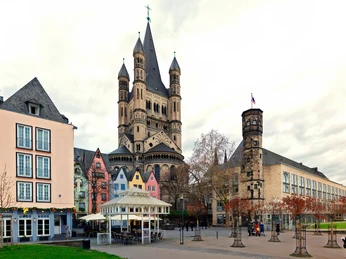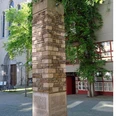- Photos & Map
How would you like to arrive?
- Call
- Details
- Useful Information
- Nearby
Imagine yourself as a Roman merchant taking a stroll through the Rhine suburb of Cologne. Newly built stone houses can be seen, and the aroma of baked goods fills the air. The vibrancy of the border town is fascinating—busy traders unload spices from the Orient and ceramics from Gaul. Snippets of Germanic and Latin languages intermingle in the bustling scene. Everywhere you see craftsmen at work, while children play between the stalls: Roman order meets Germanic wildness.
This is how it might have felt if you had been here in the 1st century, where Groß St. Martin stands today—on the former Cologne Rhine suburb, an island situated in the Rhine.
In the 2nd century AD, the area was filled in, creating a courtyard and four Roman warehouses—likely used for trade goods due to their location on the banks of the Rhine. The monastery is considered established in the 10th century; however, the Romanesque new building of the visible basilica did not begin until the 12th century.
You can descend into the accessible excavation area beneath Groß St. Martin with the foundations of the warehouses on which the basilica was built: the visit is worthwhile.
Groß St. Martin is one of 12 Romanesque churches in Cologne. With its imposing size, the basilica alongside Cologne Cathedral forms a prominently visible motif in the picturesque Cologne skyline. Before the now proven foundation by the Archbishop of Cologne, Brun, in the 10th century, a completely different story about the long history of Groß St. Martin was told. Formerly narrated as founded by the Scot Tilmon in 690, followed by destruction by the Saxons in 778 and subsequent reconstruction by the Danish prince Olger with further destruction by the Normans, this chronicle was upheld until 1900—since then it is certain: The entire chronicle was merely a fabrication by the Benedictine monk Oliver Legipont from 1730. With this revelation, a founding of the monastery and church in Frankish times was no longer substantiated.
It is certain that the basilica was considered complete only in the 13th century, for in 1150, the church also suffered in the fire of the Rhine suburb — damaged parts were presumably completely demolished. In 1185, there was another fire. Only in the mid-13th century were the galleries and niches of the triforium carved from the walls above the side aisles. The nave was also extended by five meters, and the two-bay west porch was added.
The twelve Romanesque churches are so named because their architecture indeed alludes to the Romans with similar round arches, columns, and pillars and form a semicircle around Cologne's city center. All were built between 1150 and 1250; also Groß St. Martin was only completed in the 13th century—and hardly any modifications were made until the 19th century. The only exceptions: restoration measures, such as for the roof of the crossing tower destroyed by a fire in 1378 or due to storm damage in 1434.
This is how it might have felt if you had been here in the 1st century, where Groß St. Martin stands today—on the former Cologne Rhine suburb, an island situated in the Rhine.
Roman Excavations: From the Foundations
The ancient stones of Cologne are known to speak primarily Latin, as remnants of Roman buildings lie beneath the city. Directly under Groß St. Martin, in the 1st century AD, there was likely a sports ground with a water basin, a facility not found elsewhere north of the Alps. Certainly demonstrated as the first construction was a site with a sunken area and a water basin.In the 2nd century AD, the area was filled in, creating a courtyard and four Roman warehouses—likely used for trade goods due to their location on the banks of the Rhine. The monastery is considered established in the 10th century; however, the Romanesque new building of the visible basilica did not begin until the 12th century.
You can descend into the accessible excavation area beneath Groß St. Martin with the foundations of the warehouses on which the basilica was built: the visit is worthwhile.
History – Groß St. Martin as a Benedictine Abbey
Groß St. Martin is one of 12 Romanesque churches in Cologne. With its imposing size, the basilica alongside Cologne Cathedral forms a prominently visible motif in the picturesque Cologne skyline. Before the now proven foundation by the Archbishop of Cologne, Brun, in the 10th century, a completely different story about the long history of Groß St. Martin was told. Formerly narrated as founded by the Scot Tilmon in 690, followed by destruction by the Saxons in 778 and subsequent reconstruction by the Danish prince Olger with further destruction by the Normans, this chronicle was upheld until 1900—since then it is certain: The entire chronicle was merely a fabrication by the Benedictine monk Oliver Legipont from 1730. With this revelation, a founding of the monastery and church in Frankish times was no longer substantiated.
Church and Abbey
The history of the basilica Groß St. Martin is closely linked to the Benedictine abbey. For several centuries, it served as the abbey church of the same monastery until the secularization of the monastery in the 19th century; subsequently, Groß St. Martin was used as a parish church. However, there are few documents concerning its construction, and insights into the build rely on archaeology and art history.It is certain that the basilica was considered complete only in the 13th century, for in 1150, the church also suffered in the fire of the Rhine suburb — damaged parts were presumably completely demolished. In 1185, there was another fire. Only in the mid-13th century were the galleries and niches of the triforium carved from the walls above the side aisles. The nave was also extended by five meters, and the two-bay west porch was added.
Groß St. Martin: One of the 12 Romanesque Churches of Cologne
As one of the 12 Romanesque churches of Cologne, Groß St. Martin is a striking example of Romanesque architecture. The basilica is characterized by massive walls and heavy pillars, typical of the Romanesque style. Particularly striking is the square crossing tower with the four flanking towers. Round arches dominate both windows and portals, emphasizing the architectural austerity and functionality. The block-shaped masonry highlights the structure's robustness. The design principle of the Staufen Romanesque is clearly visible: complexity of forms and structures increases horizontally from west to east and from the base to the topmost tower level.The twelve Romanesque churches are so named because their architecture indeed alludes to the Romans with similar round arches, columns, and pillars and form a semicircle around Cologne's city center. All were built between 1150 and 1250; also Groß St. Martin was only completed in the 13th century—and hardly any modifications were made until the 19th century. The only exceptions: restoration measures, such as for the roof of the crossing tower destroyed by a fire in 1378 or due to storm damage in 1434.
In Recent History
During World War II, Groß St. Martin was significantly damaged. The subsequent reconstruction measures extended over 40 years. During this time, attitudes in monument preservation and art history shifted towards valuing the creative intentions of the artists of the 19th century. Thanks to this circumstance, the surviving interior paintings from the 19th century were preserved. Groß St. Martin is the only Romanesque church in Cologne with this painting.Revived by the Monastic Communities of Jerusalem
With daily prayers, masses, and other events on all holidays, Groß St. Martin is an active church. Besides the opportunity to visit the interior, you also have the option to descend into the excavation foundations.Useful Information
Eligibility
Bad Weather Offer
for Groups
for Class
for families
for individual guests
Openings
Dayoff: Monday
Payment methods
Entrance Free
Parking facilities
The walk from Cologne main station takes about 7 minutes.
Our recommendations
Nearby



